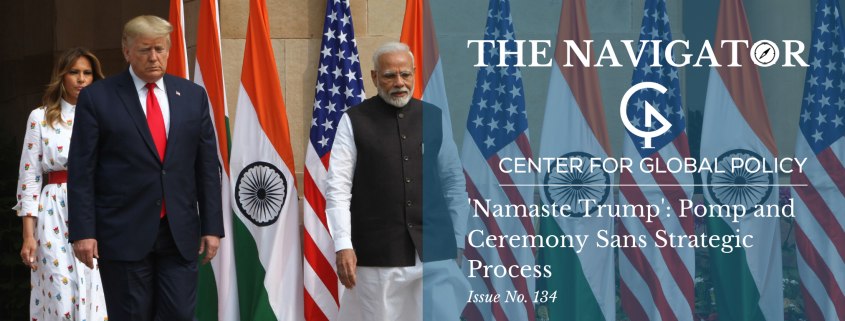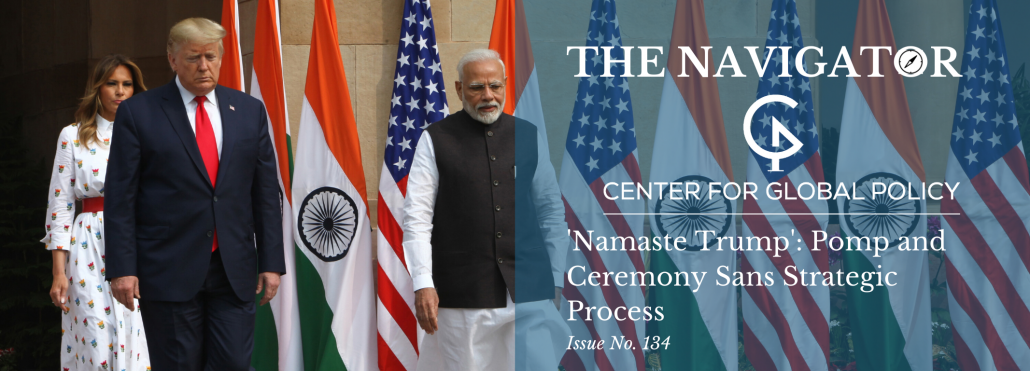‘Namaste Trump’: Pomp and Ceremony Sans Strategic Progress
The U.S. president’s visit to India is unlikely to enhance the countries’ relationship.
U.S. President Donald Trump’s recent trip to India was designed to emphasize the close relationship between the oldest and largest democracies and the friendship between Trump and Indian Prime Minister Narendra Modi while underscoring India’s growing global significance. However, several strategic issues have taken the shine off India. In the past six months, India has received incessant bad press globally because of its constitutional annexation of Kashmir and subsequent human rights violations there, the visible rise of Hindu nationalist sentiment, and Modi’s efforts to communalize Indian citizenship. The country’s economy is experiencing a setback, and its domestic politics is in turmoil. The capital, New Delhi, experienced communal violence even during the Trump visit. However, it appears that Trump’s visit focused more on political pageantry than any serious progress on key issues. This visit, though beneficial for Modi and Trump, may neither strengthen India nor strengthen U.S.-India relations.
Strategic Backdrop
Since the collapse of the Soviet Union, U.S.-Indian relations have improved slowly but steadily, to the point that today the United States sees India as a key ally in the Indo-Pacific region, the battleground where both geoeconomic and geopolitical struggles between the U.S. and China will rage. The United States now recognizes India as an economic powerhouse; India’s economy is the third largest (adjusted for purchasing power parity). India is the world’s biggest democracy, and its geographic location allows it to bookend the entire Indo-Pacific region, with India on one end and the U.S. at the other. Since 2005, consecutive U.S. administrations have been nurturing and grooming India to become a truly regional strategic partner (Trump is the fourth consecutive U.S. president to visit India.) And, according to the U.S. National Security Strategy (p. 46), the United States now sees India as an ally on par with Japan and Australia.
Four key developments have allowed this strategic partnership to grow. The first was the collapse of the Soviet Union that forced India to open up to the United States and the West in general. Until then, in spite of its leadership in the Non-Aligned Movement, India was firmly in the Soviet camp. Its defense technology and trade dynamics were enmeshed with the Soviet system.
The second development was the liberalization of the Indian economy, leading to increasing bilateral trade and U.S. investments in India. With $142 billion dollars in annual trade, the United States is India’s biggest trading partner. With U.S. investments in India amounting to $49 billion dollars and Indian investments in the U.S. crossing $9 billion, it is clear that the two nations are invested in each other’s economic fortunes.
The third and fourth developments are strategic in nature. The India-U.S. nuclear deal not only facilitates nuclear cooperation between the two nations, but also allows the growth and global engagement of Indian nuclear scientists, and has in effect legitimized India’s nuclear power status. This deal also sends confidence-building signals that India and the United States now not only trust each other but also envision a shared strategic future. This key turning point has accelerated the pace with which the two nations have come together.
The final development is the rebranding of Washington’s grand strategy in Asia from the “pivot to Asia,” which was an acknowledgment of the growing military and economic power and relevance of East Asia. The new concept – Indo-Pacific Strategy – elevates India, which is now part of the new U.S.-Australia-Japan-India partnership to keep the region open, democratic, and free from exclusive Chinese hegemony. The Indo-Pacific Strategy is the United States’ response to China’s One Belt One Road initiative. Former U.S. President Barack Obama had described this emerging relationship as the “defining partnership of the 21st century.” Trump, in his speech during the “Namaste Trump” event held in his honor, reiterated this alliance.

Map courtesy of Hankyoreh, Korea.
The Show
From a political perspective, the visit was successful. Trump got what he always wanted: the adulation of the masses overseas. He clearly enjoyed the “Namaste Trump” event, a sequel to the “Howdy Modi” event in Texas last year, with over 100,000 admiring fans in the world’s largest cricket stadium. It was another mega election rally that his loyal supporters at home are used to. Additionally, he advanced the United States’ business interests by announcing a $3 billion military helicopter deal. For Trump, this kind of reception – especially while U.S. Democrats are working through a contentious presidential primary – is a big political win.
Modi also benefits politically. Trump’s visit will not have much impact on India’s global image; on the contrary, many cringes at the “bromance,” the hugging, the mutual adulation of two majoritarian populist leaders. But at home, Modi’s dwindling political image received a major boost. Praise and public affirmation by the most powerful man on the planet will restore Modi’s popularity with his base and perhaps also rejuvenate him and his base to face ongoing political and economic challenges.
From a strategic and long-term perspective, it is clear that there has been little progress, but politically speaking, both leaders made short term gains.
Future Prospects
India’s growing global appeal was based on what I call India’s “three pillars of prominence”: democracy, secularism, and economic growth. But if the erosion of these values continues and the decline in economic growth does not reverse, then the prospects of India becoming a close partner of the United States and becoming a leader in security and global governance will evaporate rapidly. The measures taken by the Modi government in the past few months have resulted in electoral defeats in regional elections for his party, endless protests against his religiously discriminatory policies, and an avalanche of condemnation from the global civil society.
The riots and violence against Muslims in New Delhi instigated by the members of the ruling party, just 11 miles from where Trump and Modi met, exposes not only India’s domestic fragility but also Modi’s failure to govern. Trump, who loves watching TV, might have seen on Indian channels the horror show that New Delhi has become – mosque vandalized, businesses burned, over 10 dead, hundreds injured, and entire neighborhoods torched. Perhaps he might ask Modi; you cannot keep your own capital safe and free; how are you going to help keep the entire Indo-Pacific region safe and free?
If the U.S. wants India to be a worthy partner, then the U.S. must become a firm mentor. It cannot let India slide, especially on the very criteria that makes it appealing. India’s shift from good governance to Hindutvization makes it not only an unreliable partner but also a strategic risk. Washington has to firmly and publicly push back against the identity politics that Modi and his party have unleashed.
India has to play the role that Europe did during the Cold War: partner with the United States to create balance and lead to victory over communism. India could be the United States’ new partner in its confrontation with Chinese communism, but it is not there yet. Not only is the world’s biggest democracy at risk, the security and openness of the entire Indo-Pacific region is at stake. India’s meltdown into domestic strife will not only fail Washington’s Indo-Pacific Strategy but also help China dominate the region.
Dr. Muqtedar Khan is a professor at the University of Delaware and a Senior Fellow at the Center for Global Policy. Prof. Khan is the Academic Director of the State Department’s American Foreign Policy Institute (SUSI). He is the author of a new book Islam and Good Governance: A Political Philosophy of Ihsan, His website is www.ijtihad.org and he tweets at @MuqtedarKhan.

















2020
1,027 views
views
0
comments